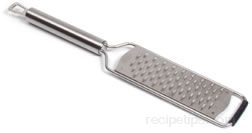|
Lime Preparation | Lime Recipes | Tips
| Limes |
|
A small green citrus fruit providing juice or peel that is added to food dishes for a refreshing, tart flavor. It is the smallest of the citrus fruit family. The flavor of a lime is stronger and more tart than a lemon, but in most cases they are interchangeable in recipes. Limes are round or oval in shape, ranging from 1 to 2 inches in diameter, and most often have a green outer skin. The limes are picked while they are still green, before they are completely mature. When completely mature, the limes are more yellowish in color and they have lost their fresh tart flavor. The flesh is greenish-yellow in color and is generally contained in 8 to 10 segments. As in other citrus fruit, there is a layer of pith beneath the outer skin.
There are sweet and sour limes but the sweet limes are not readily available in the North America. There are several varieties of limes, which vary in size and shape. Some varieties contain seeds and some are seedless. They are very high in vitamin C and low in calories. |
|
Uses:
Limes are rarely eaten raw due to their tartness but are used to flavor many sweet and savory dishes. They can be used in basically the same manner as lemons but are stronger in flavor so generally a smaller amount is required. They are used in sauces or as an accompaniment to fish and poultry. Lime juice and lime zest will enhance the flavor of fruits, vegetables, salads, and other dishes without adding fat or a lot of calories. It also allows less salt to be used. Limes are also used in baked goods and desserts to provide a light, fresh flavor. They are used in the famous Key Lime pie. They are also used as a garnish, in the form of a slice or wedge added to the plate or to the rim of a beverage glass. Lime juice is used in several popular alcoholic beverages, such as margaritas and daiquiris. Lime zest (the green part of the peel) is also used to add flavor when cooking and baking.
Besides adding flavor, limes are used for other purposes when preparing food. Their high content of vitamin C is the ascorbic acid needed to prevent the discoloring of the flesh of fruits and vegetables that oxidize quickly when exposed to the oxygen in the air. Lime juice makes a great meat tenderizer and marinade.
The high content of vitamin C in limes provides health related benefits. Lemons and limes were used back in the 18th century on British Navy ships to prevent and treat scurvy among the sailors. Limes are used as an ingredient in suntan products, cosmetics, perfumes and other beauty products. Lime juice is also used as a cleaning agent. |
| At Their Best:
Limes are available throughout the year but their peak season is May through October. Key limes are not readily available as are the Tahitian limes. They may only be found seasonally or in specialty markets. |
|
How to Buy:
Select limes that are bright green in color and have a shine to their skin, realizing that sometimes they have been coated with wax, which will also give them a shine. They should feel firm and heavy for their size, because heavy limes will produce the most juice. Select limes with thin skins, avoiding the thicker skinned fruit, which is an indication of less flesh and juice. Avoid limes that are pale green and are showing signs of yellowing, which is an indication that the limes are getting close to being fully ripe. Fully ripe limes will have lost their acidity and will be bland in flavor compared to bright green tart limes. Select those that are fairly smooth skinned, free of blemishes and do not have soft or hard spots. Small brown spots on the limes does not indicate that there is a lose of juiciness or flavor, but if the limes are mostly brown in color, that may be an indication of scald, which will cause the fruit to have a moldy flavor. Avoid limes with shriveled skin or that feel spongy, which is a sign of old fruit that will have lost a lot of its juiciness. |
|
Storage:
Limes will perish the quickest of any of the citrus fruits, so it is important that they are stored properly. Fresh limes can be stored at room temperature for up to a week if kept out of the direct sunlight. If they are not going to be used within a week, place them in a plastic bag and store them in the refrigerator where they will stay fresh for 2 weeks. After 2 weeks, they may not be spoiled but they will begin to lose their tart flavor. If limes have been cut open, wrap tightly in plastic wrap and store in the refrigerator for 4 to 5 days. Leftover fresh squeezed juice can be stored in an airtight container in the refrigerator for up to 5 days. Lime juice and zest can be stored for longer period of time by freezing them. Do not freeze whole limes. Place grated zest in an airtight freezer bag or container and store in the freezer. Freeze lime juice in ice cube trays until solid and then place in airtight freezer bags or containers and store in the freezer. To make it easier to know how many frozen cubes to use for a recipe, it is a good idea to measure the juice when placing in the ice cube tray. That way you will know the amount contained in each cube. |
| Varieties: |
|
Kaffir Limes |
A variety of lime that is small, round and gnarled in appearance that provides a strong lime smell. The kaffir lime is a subspecies of the citrus family but is not a true lime. The rind and leaves of the kaffir lime are used in recipes for curry pastes, soups and other dishes, adding a distinct citrus aroma and flavor. The rind is kept whole, cut into strips, or grated and can be used fresh or dried. The leaves are most commonly found in a dried form but can be found as fresh or frozen also. The leaves are used to season soups, shellfish, and fish dishes. The juice from the kaffir limes can also be used but they contain very little juice and it is hard to remove. Available in Asian markets, the kaffir lime can be substituted with domestic citrus leaves or regular lime rind but doing this will affect the flavor of the food being prepared. This lime is also referred to as a Kieffer, Thai or wild lime. |
|
Key Lime  |
Often referred to as the true lime, the key lime is smaller and rounder lime than the more common Persian lime. It is yellowish green in color, has a more acidic flavor than the Tahitian varieties of limes, and is known mostly for its use in key lime pie. It is very small in size, generally about the size of a golf ball or smaller. They are grown in Florida and are not always available, generally found in specialty markets and some supermarkets. Also referred to as Mexican or West Indian limes. |
|
Palestine Sweet Lime |
This sweet lime has a yellow rind that contains aromatic oil. It has a light yellow flesh, which lacks acidity and contains very few seeds. Its flesh is very juicy but lacks in taste due to the absence of any acidity. This lime is popular in the Middle East and India. |
|
Tahitian - Bearss Lim
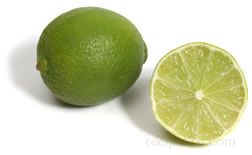
|
A Tahitian lime that is slightly smaller but very similar to the Tahitian Persian lime. It is greenish yellow when ripe but is harvested to be sold when it is still green because the acidity level is higher, which provides a better flavor. It is oval in shape and seedless. Tahitian limes have a fairly thin rind and their flesh is pale green and juicy. In the United States, the majority of Bearss limes are grown in California. |
|
Tahitian - Persian Lime
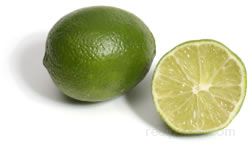
|
An oval shaped Tahitian lime that is slightly larger than Tahitian Bearss lime. It is greenish yellow when ripe but is harvested to be sold when it is still green because the acidity level is higher, which provides a better flavor. Tahitian limes have a fairly thin rind and their flesh is pale green and juicy. In the United States, the majority of Persian limes are grown in Florida. This variety is found most commonly in the food stores. The Tahitian limes are often used in the well-known key lime pie because key limes are often not available. Tahitian limes are not as acidic or aromatic as key limes. |
Lime Preparation
Preparation Tools | Cutting Slices and Wedges | Zesting | Juicing
Limes can be used in the same manner as lemons and prepared using the same basic methods. Preparation will generally involve, zesting, juicing, slicing or peeling. Some of the preparation tools and basic preparation methods are described below. Before preparing the limes in any manner, they should be washed thoroughly to remove any dirt, bacteria, or pesticide residue that may remain on the surface.
Preparation Tools
Zesting Tools
 |
Paring Knife - The tip of the paring knife is used to cut thin strips of zest from the outer peel of the lime. |
 |
Vegetable Peeler - A vegetable peeler can be used to cut wide strips of zest from the outer peel. Strips can be cut vertically from one end to the other or by cutting strips around the lime, starting at one end and working around and down towards the opposite end. |
|
The strips removed by the vegetable peeler or knife can be used as wide strips or cut into thinner strips, depending on the intended use. |
Grater - A metal grater can be used to produce fine particles of zest. The surface of the lime is rubbed diagonally across the grater and it should be turned often to avoid grating the layer of white pith. |
|

|
Citrus Zester - A zester tool can be used to remove fine strips of zest from the surface of the lime. The tool is pulled across the skin to remove the fine strips, which can then be used as strips or minced to produce a finer zest. |
Juicing Tools
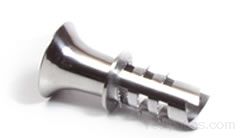 |
Citrus Trumpet - A tool used to extract the desired amount of juice from citrus fruits. This tool is screwed into the fruit and the outer rind is squeezed until the desired amount of juice flows out the spout of the extractor. This type of tool is also known as a juice extractor. |
|
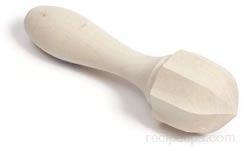
|
Reamer - A hand tool that is typically used to extract juice from citrus fruits, such as lemons, limes and oranges. This kitchen utensil has a fluted cone-shaped reaming end that is twisted into and against the meat of the fruit to release the juice. It is available in hard plastic, wood, or metal. The hand reamer is primarily made to extract smaller volumes of juice from fruits during food preparation. |
|

|
Hand Juicer - Hand juicers are generally built with a solid ribbed cone that is attached to a shallow bowl type base or it may be a separate piece that attaches to a base that is used for collecting the juice. The lime half is pressed down onto the cone and turned manually. As it revolves around the cone, the pulp is crushed and the liquid flows into the bowl or holding platter below. |
|
Citrus Press - This hand press is similar to a hand juicer in that it works with a cone to remove the juice. The fruit is place on the cone and then a press is forced done on the fruit, forcing the juice out with pressure rather than by a twisting motion.
Electric Juicers - This machine works with a motor that turns the reamer as it extracts the juice. The half section of fruit is pressed down on the reamer and the motor starts the reamer rotating and continues rotating until the fruit is released. The juice flows into a pitcher or other holding container that is part of the juicer. |
Cutting Slices and Wedges
|
Slices
Wash limes thoroughly before cutting.
To create lime slices, cut the lime in half crosswise and then cut slices crosswise from each half. Cut the slices 1/8 to 1/4 inch thick. |
 |
|
Wedges
Wash limes thoroughly before cutting.
After washing, cut the limes in half lengthwise. |
 |
| Cut each section lengthwise again to create wedges. Each lime half can be cut into more than two wedges, if desired. The number of wedges cut from each half will depend on the size of the lime and on the desired thickness of the wedges. |
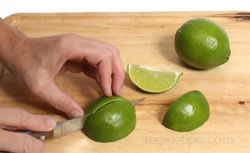 |
|
For added interest the limes can be cut in another manner to form a little different type of wedge. First cut the lime in half lengthwise as shown above.
Place the lime half flesh side down. Using a sharp knife, make a small lengthwise angled cut in the middle of the lime. Make another small angled cut on opposite side of the first cut to form a small wedge to be removed from the rind of the lime. |
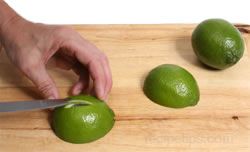 |
| Continue to cut more wedges from the lime by making cuts along the sides of the previous cuts. Remove the wedge and continue cutting wedges until no more wedges can be cut from the half. |
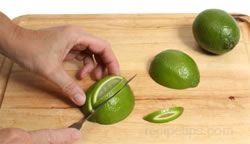 |
| Use the wedges individually or place several together to form a larger garnish. |
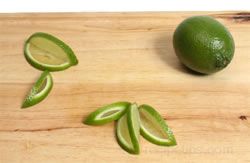 |
Zesting Limes
Lime zest is the green outer peel of the lime, which provides an aromatic flavor that enhances the flavor of many foods. The white part of the peel beneath the zest is the pith, which has a bitter taste. When removing the zest from a lime, care should be taken to not remove the white pith along with it. The zest from the lime and other citrus fruits can be removed as wide or thin strips, very thin strands or grated pieces. Shown below are some common methods used for creating zest.
|
Wash limes thoroughly before beginning preparation.
Lime zest strips can be made by using the tip of a small knife and cutting vertical strips off the lime. Be careful not to cut into the bitter pith layer. |
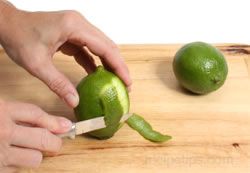 |
| A vegetable peeler can be used in the same manner as a knife to cut vertical zest strips. The zest could also be removed in the same manner that you would peel an apple with the vegetable peeler. Start peeling at the stem end of the lime and instead of cutting vertically, cut around the lime, working down towards the blossom end. |
 |
| Be careful not to cut into the bitter pith layer when cutting strips of zest from the lime. If you do get some of the pith layer, use the tip of the knife to cut or scrape the pith from the zest strip. |
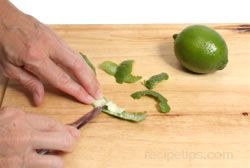 |
|
The strips can then be used as is or they can be trimmed to thinner strips, depending on the intended use.
To julienne, cut the strips lengthwise into the desired thickness. |
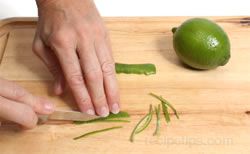 |
|
To grate the lime zest, rub the lime diagonally against a metal grater, making sure to turn the fruit so that you are taking off the green part of the peel and not the white pith. |
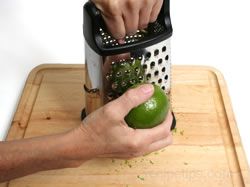 |
| Grating the line peel will produce fine pieces of zest. |
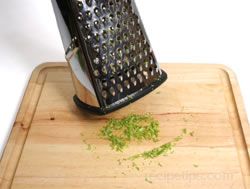 |
| A citrus zester can also be used to remove the zest from the lime. The zester removes the zest in fine threads, which can be used just as they are or they can be minced and used as an alternative to grating. |
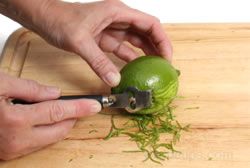 |
Juicing Limes
Lime juice can be used in place of lemon juice in most recipes but because their acidic level is higher they will provide a slightly sharper taste. Limes can be used to enhance the flavor of many dishes. It can be added to both sweet and savory dishes to provide a fresh flavor. Because of its high content of ascorbic acid, lime juice is also brushed on fruits and vegetables that brown easily when exposed to air or it is added to water and the fruit is soaked in the acidulated water for a short period of time to prevent it from browning. Shown below are some methods that can be used for removing the juice from the limes.
| The limes should be room temperature or warmer before the juice is removed. This will make it easier to squeeze the juice from the fruit. |
| Limes can be warmed by placing in the microwave. First poke the skin of the lime with a fork, being careful not to poke all the way through the skin to the flesh.
Place the lime(s) in the microwave on high for 20 to 30 seconds. |
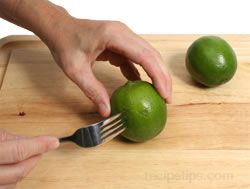 |
| Limes can also be warmed by placing them in a bowl and pouring boiling water over them. Allow them to sit in the hot water for 30 seconds. |
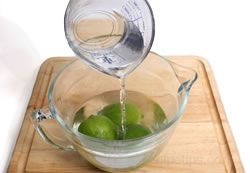 |
| After the limes have been warmed, roll them on a solid surface using the palm of your hand. Be sure the limes have cooled enough first to allow them to be handled safely. Roll until you feel the flesh softening. |
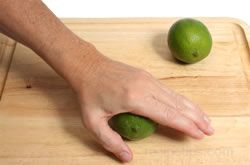 |
|
After rolling the limes, cut them in half crosswise. Place one half of the lime on the juicer, apply pressure and twist it to remove the juice.
The juice can also be removed by squeezing the lime by hand. |
 |
|
If the type of limes used had seeds, remove all the seeds from the juicer once you have finished. |
|
The extra pulp that has collected in the bottom of the juicer can be added to the lime juice once the seeds have been removed, unless pulp-free juice is required. If it is necessary to use pulp-free juice, strain juice to separate any pulp that may have gotten into the juice.
Store any leftover juice in the refrigerator for up to 5 days. |
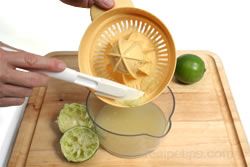 |
|
Partial Juicing of a Lime
If you do not need all the juice from a lime at one time, you can squeeze the amount you need from the fruit and then store the remainder to use later.
If the limes are not room temperature, warm them as shown above. Roll them to loosen the flesh and then using a toothpick, poke through the skin into the flesh. |
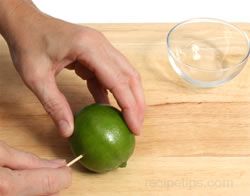 |
| Remove the toothpick and squeeze juice through the hole until you have removed the required amount. If the juice is hard to squeeze out, poke the hole several more times with the toothpick and try squeezing again. |
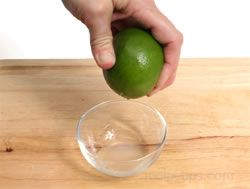 |
| After the required amount has been squeezed out, place the toothpick back into the hole in the lime, place it in a sealable bag, and store in the refrigerator until needed. |
 |
Lime Recipes
Key Lime Pie
|
Key lime pie got its name because key limes were the main ingredients that gave the pie its fresh flavor. Now most often key lime pie is made with regular limes, generally one of the Tahitian varieties.
This recipe can be made with regular limes but if you have access to good key limes, use them for a more distinct flavor and aroma. |
| A pastry pie crust or a graham cracker crust can be used for key lime pies. Prepare the pie crust and allow it to cool before adding the filling. |
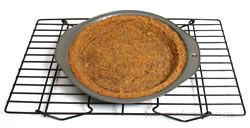 |
|
Filling:
Produce 2 teaspoons of finely grated lime zest by running lime diagonally across a hand grater. Set zest aside while preparing other ingredients. |
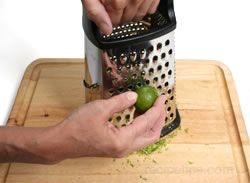 |
|
Squeeze juice from enough limes to produce 1 cup of juice. This requires approximately 8 medium size limes. The limes that have had the zest removed can be used. If using key limes it may take 20 to 24 key limes to produce 1 cup of juice. |
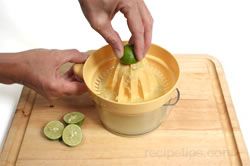 |
|
Combine 2 14-ounce cans of sweetened condensed milk, 2 large egg yolks, 1 cup of lime juice, and 2 teaspoons of fine grated lime zest in a medium bowl. |
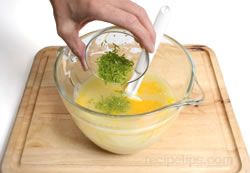 |
| Beat ingredients until they are all well blended together.. |
 |
| Pour the filling into the cooled pie crust and then place the pie into an oven preheated to 350° F. |
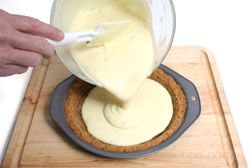 |
|
Bake for approximately 30 minutes or just until the filling is set. The middle may not be completely firm. For accurate doneness, check the temperature of the center of the pie. Temperature should be at least 140° F.
Allow the pie to cool completely. Cover with plastic and then refrigerate for at least 3 hours. Pie should be completely chilled. Do not refrigerate for over 24 hours before the topping is added. |
|
Topping and Garnish:
Create thin strips of zest from one lime by using a zester tool or by slicing strips of zest with a vegetable peeler and cutting them into thin julienne strips. See above for zesting. Set zest aside until topping is on the pie.
|
| Add 1 tablespoon of sugar to 1 cup of heavy cream and whip until stiff peaks are formed. Spread the whipped cream on the filling and garnish with the strips of lime zest. The pie is then ready to be served. |
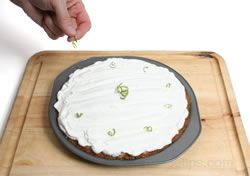 |
Tips
- Prevent browning of fresh cut fruits and vegetables by placing them into a mixture of 1 cup water and 1 tablespoon lime juice, allowing them to soak for 5 or 10 minutes, or by brushing fruits and vegetables with full strength lime juice.
- One pound of limes equals approximately 6 to 8 medium whole limes and 1/2 to 3/4 cup of juice. One medium lime equals approximately 1 1/2 to 2 tbsp. of juice, 1 1/2 tsp. grated peel, and 6 to 8 slices.
- Another method that can be used to make limes easier to extract the juice is to freeze them for 24 hours and then thaw in the refrigerator before juicing.
- To prevent lime wedges from squirting juice in unwanted areas, pierce the flesh of the lime wedge with a fork before squeezing.
- Cut down on the amount of salt used on your food by adding lime instead to enhance the flavor of the food.
- Lime juice can be used as a marinade to tenderize meat.
- Do not use aluminum pans when cooking with limes because the acid in the limes reacts with the aluminum and affect the flavor and color of the food.
|












